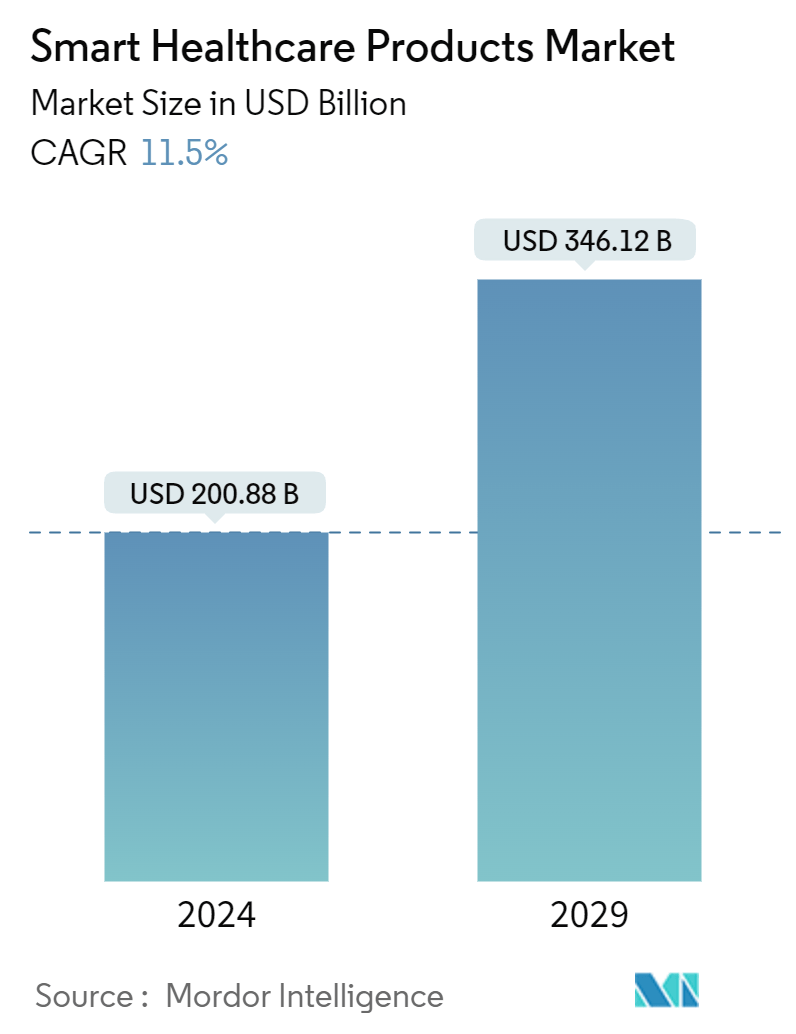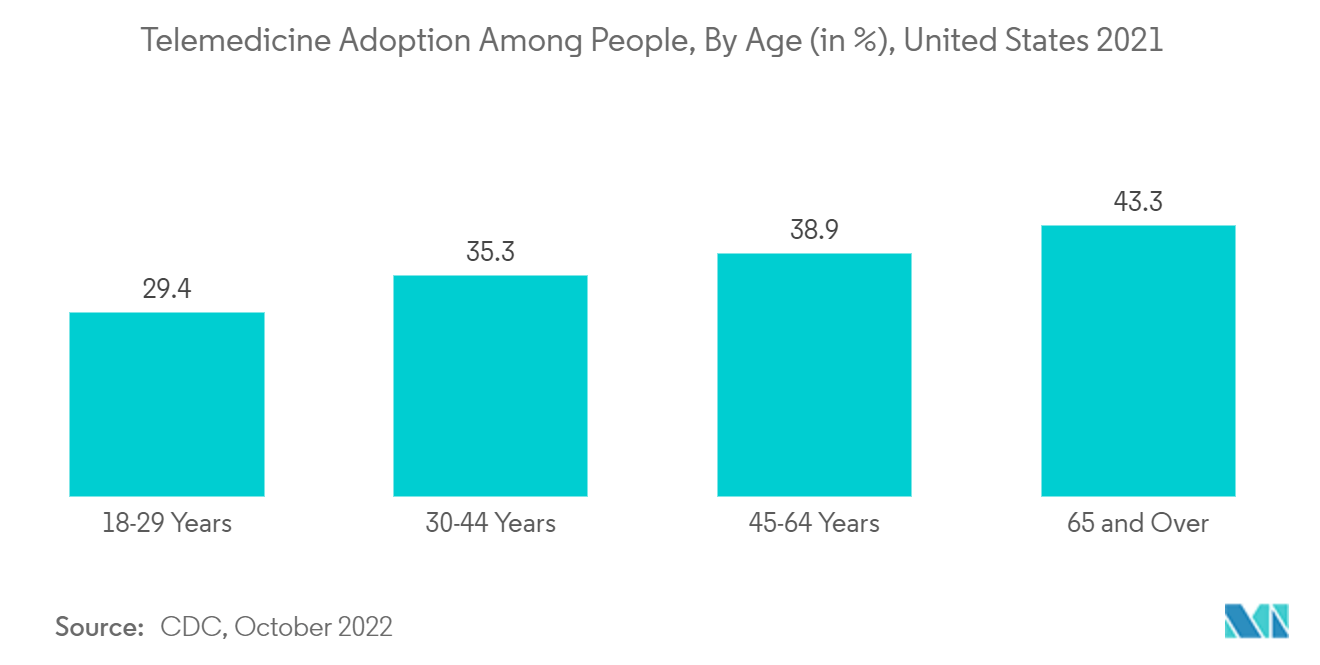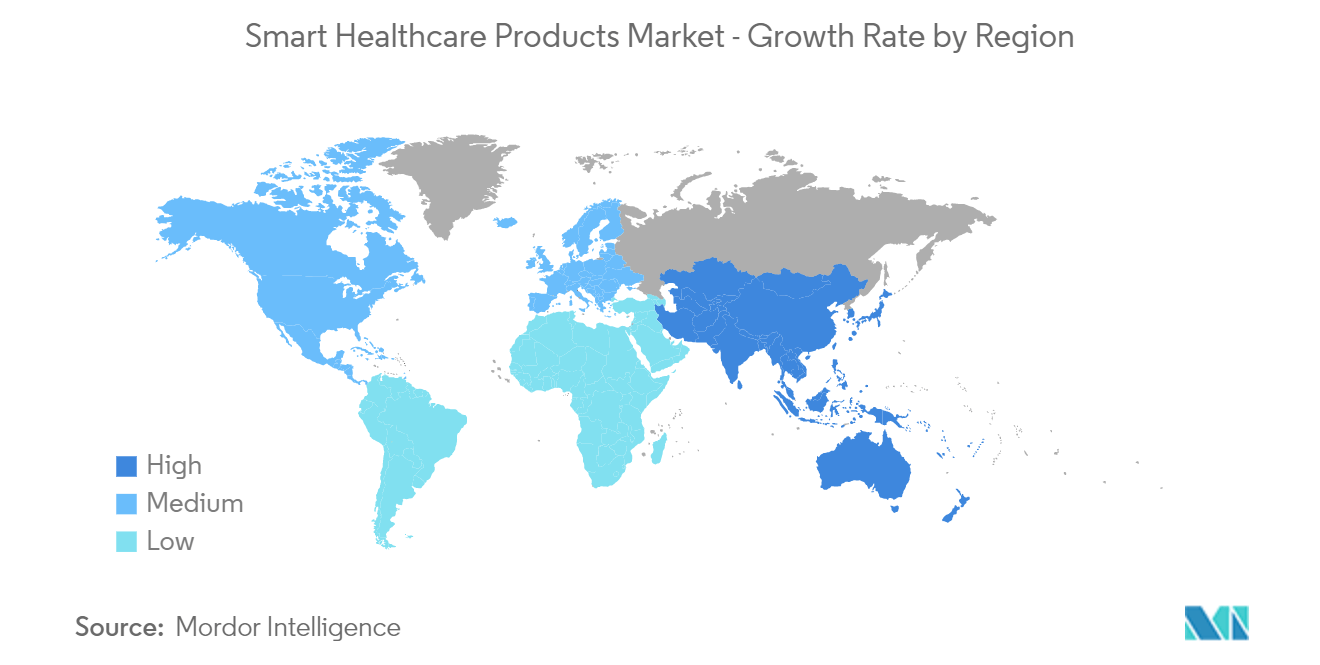Smart Healthcare Market Size

| Study Period | 2019 - 2029 |
| Market Size (2024) | USD 200.88 Billion |
| Market Size (2029) | USD 346.12 Billion |
| CAGR (2024 - 2029) | 11.50 % |
| Fastest Growing Market | Asia-Pacific |
| Largest Market | North America |
Major Players
*Disclaimer: Major Players sorted in no particular order |
Smart Healthcare Market Analysis
The Smart Healthcare Products Market size is estimated at USD 200.88 billion in 2024, and is expected to reach USD 346.12 billion by 2029, growing at a CAGR of 11.5% during the forecast period (2024-2029).
With the emergence of COVID-19, smart healthcare products observed a sudden upsurge in demand. As a result, many companies are expanding their products and services. For instance, according to a study published in IEEE Access in January 2022, a smart health monitoring system was developed using Internet of Things (IoT) technology, which is capable of monitoring blood pressure, heart rate, oxygen level, and temperature of a person, thus helping manage COVID-19 patients. The demand for smart health products increased during the pandemic, which significantly influenced the market's growth. The market is also projected to expand in the following years due to an increase in the use of smart healthcare products to effectively monitor health outcomes, along with the development of technologically advanced products that encourage customers to purchase these devices.
Smart healthcare products are based on the new generation of information technologies, such as the internet of things (loT), big data, cloud computing, and artificial intelligence, to transform the traditional medical system and make healthcare more efficient, convenient, and personalized. Smart healthcare products are undergoing technological developments due to their increasing penetration in the healthcare market. Various initiatives by public and private players, such as product launches and approvals, are also driving the growth of the market. For instance, in January 2021, Apple Inc. partnered with Biogen, a biotechnology company, for a study on detecting the signs of cognitive impairment early through its wearable devices. Similarly, in November 2021, Honeywell launched the Real-Time Health Monitoring System (RTHMS), a smart edge-to-cloud communication platform that acts as a bridge between caregivers and patients for remote and real-time monitoring of patients. The solution combines hardware and software to improve care delivery, increase worker productivity, and streamline processes.
The growing adoption of IoT in healthcare is expected to boost the market. In healthcare, IoT applications benefit patients, families, physicians, hospitals, and insurance companies. According to the study published in Oral Biology and Craniofacial Research in April 2022, IoT is a developing technology that delivers enhancements and improved solutions in the medical area, such as proper medical record-keeping, sample, device integration, and illness causes. Sensor-based IoT technology has the potential to significantly minimize the risk of surgery in complex circumstances. Thus, such advantages are expected to raise the demand for IoT-based smart healthcare products, thereby boosting the growth of the market.
However, high cost of smart healthcare products may restrain the market over the forecast period.
Smart Healthcare Market Trends
The mHealth Segment is Expected to Observe Good Growth in the Market
mHealth is a component of eHealth. The National Institutes of Health (NIH) defined mHealth as the use of mobile and wireless devices that include cell phones, tablets, patient monitoring devices, and personal digital assistance (PDAs) to improve health outcomes, healthcare services, and health research. The segment is driven by a rise in the use of smartphones and tablets.
A growing preference for mobile technology, the internet, and mounting demand for digital health is expected to boost the segment's growth. The launch of various programs with increased adoption of smart health is also supporting the market's growth. For instance, in August 2021, Athenahealth and Smile Foundation launched the Smile on Wheels mobile health unit in Chennai. Athenahealth is providing financial support to a Smile on Wheels mobile health unit, which will offer primary healthcare services in an area in Chennai with approximately 17,600 households and 88,000 residents. Smile on Wheels is a national-level mobile hospital program catering to underprivileged children and women. Such initiatives may increase the adoption of health and create awareness about health technology, thereby boosting the growth of the segment.
Product launches by the key market players are also expected to propel the growth of the segment. For instance, in September 2021, Mount Sinai Health System launched a comprehensive mobile application for patients called MyMountSinai. This app is an online gateway to Mount Sinai physicians and services, helping patients manage their medical information, communicate with their doctors, and get details on health services available at the Mount Sinai Health System.
Hence, the rising adoption of mHealth and product launches by market players are expected to boost the segment's growth, which may also augment the market's growth over the forecast period.

North America Holds a Significant Share in the Market and May Continue to do the Same during the Forecast Period
The smart healthcare product market is expected to grow in the North American region due to supportive government policies for the deployment of digital health and the accessibility of infrastructure with high digital literacy. The presence of key market participants, growing awareness about connected healthcare, high penetration of the internet and smartphones, and the usage of health-related apps are a few key factors responsible for the growth of the regional market. According to a study published in Nature Review Cardiology in August 2021, an estimated 20% of US residents currently own a smart wearable device to monitor their health. Thus, with the rising adoption of smart wearable devices in the country, the market is expected to grow over the forecast period.
The continuous product launches with new advancements are boosting the growth of the market in the region. For instance, in April 2021, the American Health Information Management Association (AHIMA), together with Moxe, launched AHIMA dHealth, a mHealth resource and assessment tool for vendors. In March 2022, RespiraLabs, a respiratory healthcare tech business based in the United States, released Sylvee, an AI-powered wearable lung monitor that employs acoustic resonance to assess lung function and identify variations in lung air volume. It can aid in the early detection and treatment of chronic obstructive pulmonary disease (COPD), asthma, and COVID-19. Thus, the growing prevalence of chronic diseases and product launches are expected to boost the smart healthcare products market in the region over the forecast period.

Smart Healthcare Industry Overview
The smart healthcare products market is at a growing stage, and it is moderately competitive. Market players focus on new product launches, such as essential cardiology and blood glucose monitors. Smartwatches, health monitors, pedometers, and activity trackers are smart wearable devices launched by several companies. Companies are focusing on industry collaborations, mergers, acquisitions, and partnerships to enhance their presence in the smart healthcare products market. Some of the key players are Honeywell Life Care Solutions, AirStrip Technologies, and Olympus Corporation, among others.
Smart Healthcare Market Leaders
-
Honeywell Life Care Solutions
-
Allscripts Healthcare Solutions, Inc
-
Abbott Laboratories
-
GE Healthcare
-
Olympus Corporation
*Disclaimer: Major Players sorted in no particular order

Smart Healthcare Market News
- In March 2022, Intuitive MB launched its medical building operating system, which uses the Internet of Things (IoT), artificial intelligence (AI), and machine learning technologies to create "smart" hospitals and medical office buildings.
- In March 2022, Commonwealth Bank launched a new smart terminal, Smart Health, which helped all major Australian private health insurers improve payments and claim experience.
Smart Healthcare Market Report - Table of Contents
1. INTRODUCTION
- 1.1 Study Assumptions and Market Definition
- 1.2 Scope of the Study
2. RESEARCH METHODOLOGY
3. EXECUTIVE SUMMARY
4. MARKET DYNAMICS
- 4.1 Market Overview
-
4.2 Market Drivers
- 4.2.1 Technological Advancements in Smart Healthcare Products
- 4.2.2 Booming Internet of Things (IoT) in the Healthcare Industry
-
4.3 Market Restraints
- 4.3.1 High Cost of Smart Healthcare Products
-
4.4 Industry Attractiveness - Porter's Five Forces Analysis
- 4.4.1 Threat of New Entrants
- 4.4.2 Bargaining Power of Buyers/Consumers
- 4.4.3 Bargaining Power of Suppliers
- 4.4.4 Threat of Substitute Products
- 4.4.5 Intensity of Competitive Rivalry
5. MARKET SEGMENTATION (Market Size by Value - USD million)
-
5.1 By Product Type
- 5.1.1 Telemedicine
- 5.1.2 Electronic Health Records
- 5.1.3 mHealth
- 5.1.4 Smart Pills and Syringes
- 5.1.5 Smart RFID Cabinets
- 5.1.6 Other Product Types
-
5.2 By Application
- 5.2.1 Storage and Inventory Management
- 5.2.2 Monitoring
- 5.2.3 Treatment
- 5.2.4 Other Applications
-
5.3 By End User
- 5.3.1 Hospitals
- 5.3.2 Home Care Settings
- 5.3.3 Other End Users
-
5.4 By Geography
- 5.4.1 North America
- 5.4.1.1 United States
- 5.4.1.2 Canada
- 5.4.1.3 Mexico
- 5.4.2 Europe
- 5.4.2.1 Germany
- 5.4.2.2 United Kingdom
- 5.4.2.3 France
- 5.4.2.4 Spain
- 5.4.2.5 Italy
- 5.4.2.6 Rest of Europe
- 5.4.3 Asia-Pacific
- 5.4.3.1 China
- 5.4.3.2 Japan
- 5.4.3.3 India
- 5.4.3.4 Australia
- 5.4.3.5 South Korea
- 5.4.3.6 Rest of Asia-Pacific
- 5.4.4 Middle East and Africa
- 5.4.4.1 GCC
- 5.4.4.2 South Africa
- 5.4.4.3 Rest of Middle East and Africa
- 5.4.5 South America
- 5.4.5.1 Brazil
- 5.4.5.2 Argentina
- 5.4.5.3 Rest of South America
6. COMPETITIVE LANDSCAPE
-
6.1 Company Profiles
- 6.1.1 Olympus Corporation
- 6.1.2 Abbott Laboratories
- 6.1.3 GE Healthcare
- 6.1.4 Koninklijke Philips NV
- 6.1.5 Samsung Healthcare
- 6.1.6 Siemens Healthineers AG
- 6.1.7 Oracle Corporation (Cerner Corporation)
- 6.1.8 McKesson Corporation
- 6.1.9 Next Gen Healthcare
- 6.1.10 Medtronic (Given Imaging Inc.)
- 6.1.11 Life Sense
- 6.1.12 Capsule Technologies Inc.
- *List Not Exhaustive
7. MARKET OPPORTUNITIES AND FUTURE TRENDS
** Subject To AvailablitySmart Healthcare Industry Segmentation
As per the scope of the report, smart healthcare products improve outcomes related to diagnostic tools and enhance patient treatment, along with improving their quality of life. Smart health products come with embedded communication, sensor technologies, and data analytics techniques. These products are used for monitoring individuals physically for diagnosis and ongoing disease treatments.
The smart healthcare products market is expected to register a CAGR of 8.5% over the forecast period. The smart healthcare products market is segmented by product type (telemedicine, electronic health records, mHealth, smart pills and syringes, and smart RFID cabinets), application (storage and inventory management, monitoring, treatment, and other applications), end user (hospitals, home care settings, and other end users), and geography (North America, Europe, Asia-Pacific, Middle East and Africa, and South America). The market report also covers the estimated market sizes and trends for 17 different countries across major regions globally. The report offers the market size and forecasts in value (USD million) for the above segments.
| By Product Type | Telemedicine | |
| Electronic Health Records | ||
| mHealth | ||
| Smart Pills and Syringes | ||
| Smart RFID Cabinets | ||
| Other Product Types | ||
| By Application | Storage and Inventory Management | |
| Monitoring | ||
| Treatment | ||
| Other Applications | ||
| By End User | Hospitals | |
| Home Care Settings | ||
| Other End Users | ||
| By Geography | North America | United States |
| Canada | ||
| Mexico | ||
| By Geography | Europe | Germany |
| United Kingdom | ||
| France | ||
| Spain | ||
| Italy | ||
| Rest of Europe | ||
| By Geography | Asia-Pacific | China |
| Japan | ||
| India | ||
| Australia | ||
| South Korea | ||
| Rest of Asia-Pacific | ||
| By Geography | Middle East and Africa | GCC |
| South Africa | ||
| Rest of Middle East and Africa | ||
| By Geography | South America | Brazil |
| Argentina | ||
| Rest of South America |
Smart Healthcare Market Research FAQs
How big is the Smart Healthcare Products Market?
The Smart Healthcare Products Market size is expected to reach USD 200.88 billion in 2024 and grow at a CAGR of 11.5% to reach USD 346.12 billion by 2029.
What is the current Smart Healthcare Products Market size?
In 2024, the Smart Healthcare Products Market size is expected to reach USD 200.88 billion.
Who are the key players in Smart Healthcare Products Market?
Honeywell Life Care Solutions, Allscripts Healthcare Solutions, Inc, Abbott Laboratories, GE Healthcare and Olympus Corporation are the major companies operating in the Smart Healthcare Products Market.
Which is the fastest growing region in Smart Healthcare Products Market?
Asia-Pacific is estimated to grow at the highest CAGR over the forecast period (2024-2029).
Which region has the biggest share in Smart Healthcare Products Market?
In 2024, the North America accounts for the largest market share in Smart Healthcare Products Market.
What years does this Smart Healthcare Products Market cover, and what was the market size in 2023?
In 2023, the Smart Healthcare Products Market size was estimated at USD 177.78 billion. The report covers the Smart Healthcare Products Market historical market size for years: 2019, 2020, 2021, 2022 and 2023. The report also forecasts the Smart Healthcare Products Market size for years: 2024, 2025, 2026, 2027, 2028 and 2029.
Smart Healthcare Industry Report
Statistics for the 2024 Smart Healthcare market share, size and revenue growth rate, created by Mordor Intelligence™ Industry Reports. Smart Healthcare analysis includes a market forecast outlook to 2029 and historical overview. Get a sample of this industry analysis as a free report PDF download.



